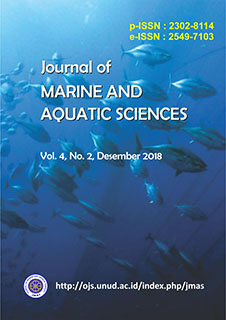Identifikasi Kandungan Senyawa Fitokimia Pada Daun dan Akar Lamun di Pantai Samuh Bali
Abstract
Seagrass is the only flowering plant which has a true roots, leaves, and stems, an angiosperm plant that adapted to live entirely in the ocean. Seagrass produces several compounds which produced through secondary metabolism, one of the secondary metabolism is the phytochemicals. Seagrass ecosystem in Tanjung Benoa was discovered along Samuh Beach, where 9 kinds of seagrass species were found around the seagrass ecosystem in Tanjung Benoa. Samuh Beach has a tranquil water conditions and sandy substrate. The activities of marine tourism and hotel waste disposal in Tanjung Benoa waters cause major ecological pressure and physical pressure for the seagrass ecosystem. This study aims to determine the content of phytochemicals in the leaves and roots of seagrass. Screening method was used to determine the content of bioactive alkaloids, flavonoids, saponins, steroids, and tannin compounds. Each of these compounds has an important role in the seagrass. The existence of chemical compounds of the flavonoid, alkaloid and steroid groups in the roots and leaves of Cymodocea rotundata seagrass, Enhalus acoroides, Thalassia hemprichi, Halophila ovalis, Halophila minor, Halodule uninervis and Sryngodium isoetifolium in this study indicate that the seven species of seagrass has potential as a natural chemical antifouling, antifungal, and antibacterial.Then the seagrass will be protected from the danger of predators or epiphanies that interfere with the growth of seagrass and the ecosystems on Samuh Beach will remain intact.
Downloads

This work is licensed under a Creative Commons Attribution 3.0 International License.
Copyright 2012 - 2023 Journal of Marine and Aquatic Sciences (JMAS)
Published by Fakultas Kelautan dan Perikanan Universitas Udayana, Denpasar, Bali, Indonesia
JMAS (p-ISSN 2302-8114; e-ISSN 2549-7103)


